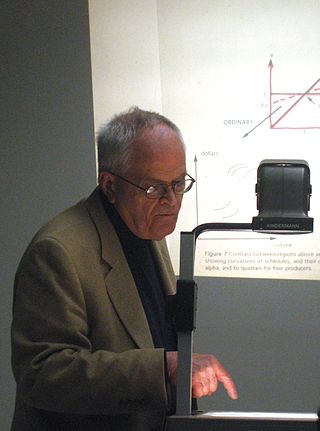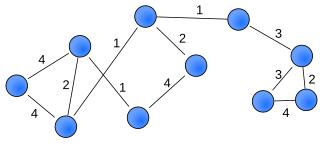Related Research Articles

Vladimir Batagelj is a Slovenian mathematician and an emeritus professor of mathematics at the University of Ljubljana. He is known for his work in discrete mathematics and combinatorial optimization, particularly analysis of social networks and other large networks (blockmodeling).

Social network analysis (SNA) is the process of investigating social structures through the use of networks and graph theory. It characterizes networked structures in terms of nodes and the ties, edges, or links that connect them. Examples of social structures commonly visualized through social network analysis include social media networks, meme spread, information circulation, friendship and acquaintance networks, peer learner networks, business networks, knowledge networks, difficult working relationships, collaboration graphs, kinship, disease transmission, and sexual relationships. These networks are often visualized through sociograms in which nodes are represented as points and ties are represented as lines. These visualizations provide a means of qualitatively assessing networks by varying the visual representation of their nodes and edges to reflect attributes of interest.

Quantitative research is a research strategy that focuses on quantifying the collection and analysis of data. It is formed from a deductive approach where emphasis is placed on the testing of theory, shaped by empiricist and positivist philosophies.

In mathematics, computer science and network science, network theory is a part of graph theory. It defines networks as graphs where the nodes or edges possess attributes. Network theory analyses these networks over the symmetric relations or asymmetric relations between their (discrete) components.

In sociology, social complexity is a conceptual framework used in the analysis of society. In the sciences, contemporary definitions of complexity are found in systems theory, wherein the phenomenon being studied has many parts and many possible arrangements of the parts; simultaneously, what is complex and what is simple are relative and change in time.

Computational sociology is a branch of sociology that uses computationally intensive methods to analyze and model social phenomena. Using computer simulations, artificial intelligence, complex statistical methods, and analytic approaches like social network analysis, computational sociology develops and tests theories of complex social processes through bottom-up modeling of social interactions.

Barry Wellman is an American-Canadian sociologist and is the co-director of the Toronto-based international NetLab Network. His areas of research are community sociology, the Internet, human-computer interaction and social structure, as manifested in social networks in communities and organizations. His overarching interest is in the paradigm shift from group-centered relations to networked individualism. He has written or co-authored more than 300 articles, chapters, reports and books. Wellman was a professor at the Department of Sociology, University of Toronto for 46 years, from 1967 to 2013, including a five-year stint as S.D. Clark Professor.

Harrison Colyar White is the emeritus Giddings Professor of Sociology at Columbia University. White played an influential role in the “Harvard Revolution” in social networks and the New York School of relational sociology. He is credited with the development of a number of mathematical models of social structure including vacancy chains and blockmodels. He has been a leader of a revolution in sociology that is still in process, using models of social structure that are based on patterns of relations instead of the attributes and attitudes of individuals.

Mathematical sociology or the sociology of mathematics is an interdisciplinary field of research concerned both with the use of mathematics within sociological research as well as research into the relationships that exist between maths and society.
Dynamic network analysis (DNA) is an emergent scientific field that brings together traditional social network analysis (SNA), link analysis (LA), social simulation and multi-agent systems (MAS) within network science and network theory. Dynamic networks are a function of time to a set of graphs; for each time point there is a graph. This is akin to the definition of dynamical systems, in which the function is from time to an ambient space, where instead of ambient space time is translated to relationships between pairs of vertices.
The International Network for Social Network Analysis (INSNA) is a professional academic association of researchers and practitioners of social network analysis. Members have interests in social networks as a new theoretical paradigm, in methodological developments, and in a variety of applications of different types of social networks approaches, social network software, and social networking.

A weighted network is a network where the ties among nodes have weights assigned to them. A network is a system whose elements are somehow connected. The elements of a system are represented as nodes and the connections among interacting elements are known as ties, edges, arcs, or links. The nodes might be neurons, individuals, groups, organisations, airports, or even countries, whereas ties can take the form of friendship, communication, collaboration, alliance, flow, or trade, to name a few.

A social network is a social structure made up of a set of social actors, sets of dyadic ties, and other social interactions between actors. The social network perspective provides a set of methods for analyzing the structure of whole social entities as well as a variety of theories explaining the patterns observed in these structures. The study of these structures uses social network analysis to identify local and global patterns, locate influential entities, and examine network dynamics.

NodeXL is a network analysis and visualization software package for Microsoft Excel 2007/2010/2013/2016. The package is similar to other network visualization tools such as Pajek, UCINet, and Gephi. It is widely applied in ring, mapping of vertex and edge, and customizable visual attributes and tags. NodeXL enables researchers to undertake social network analysis work metrics such as centrality, degree, and clustering, as well as monitor relational data and describe the overall relational network structure. When applied to Twitter data analysis, it showed the total network of all users participating in public discussion and its internal structure through data mining. It allows social Network analysis (SNA) to emphasize the relationships rather than the isolated individuals or organizations, allowing interested parties to investigate the two-way dialogue between organizations and the public. SNA also provides a flexible measurement system and parameter selection to confirm the influential nodes in the network, such as in-degree and out-degree centrality. The software contains network visualization, social network analysis features, access to social media network data importers, advanced network metrics, and automation.
Stanley Wasserman is an American statistician and prior to retirement was the Rudy Professor of Statistics, Psychology, and Sociology at Indiana University Bloomington and the Academic Supervisor of the International laboratory for Applied Network Research at Moscow's National Research University – Higher School of Economics. He is known for his work on social network analysis, mathematical sociology, network science and multidimensional network. In 2017 Wasserman launched the Master's program 'Applied statistics with Network Analysis' at National Research University – Higher School of Economics.

Network homophily refers to the theory in network science which states that, based on node attributes, similar nodes may be more likely to attach to each other than dissimilar ones. The hypothesis is linked to the model of preferential attachment and it draws from the phenomenon of homophily in social sciences and much of the scientific analysis of the creation of social ties based on similarity comes from network science. In fact, empirical research seems to indicate the frequent occurrence of homophily in real networks. Homophily in social relations may lead to a commensurate distance in networks leading to the creation of clusters that have been observed in social networking services. Homophily is a key topic in network science as it can determine the speed of the diffusion of information and ideas.
Structural holes is a concept from social network research, originally developed by Ronald Stuart Burt. A structural hole is understood as a gap between two individuals who have complementary sources to information. The study of structural holes spans the fields of sociology, economics, and computer science. Burt introduced this concept in an attempt to explain the origin of differences in social capital. Burt’s theory suggests that individuals hold certain positional advantages/disadvantages from how they are embedded in neighborhoods or other social structures.

Autologistic actor attribute models (ALAAMs) are a family of statistical models used to model the occurrence of node attributes in network data. They are frequently used with social network data to model social influence, the process by which connections in a social network influence the outcomes experienced by nodes. The dependent variable can strictly be binary. However, they may be applied to any type of network data that incorporates binary, ordinal or continuous node attributes as dependent variables.

Blockmodeling is a set or a coherent framework, that is used for analyzing social structure and also for setting procedure(s) for partitioning (clustering) social network's units, based on specific patterns, which form a distinctive structure through interconnectivity. It is primarily used in statistics, machine learning and network science.
Andrej Mrvar is a Slovenian computer scientist and a professor at the University of Ljubljana. He is known for his work in network analysis, graph drawing, decision making, virtual reality, electronic timing and data processing of sports competitions.
References
- ↑ Padgett, John F.; Ansell, Christopher K. (1993). "Robust Action and the Rise of the Medici, 1400-1434" (PDF). American Journal of Sociology . University of Chicago Press. 98 (6): 1259–1319. doi:10.1086/230190. ISSN 0002-9602. S2CID 56166159. Archived from the original (PDF) on 3 March 2020.
- ↑ Wasserman & Faust, Social Network Analysis Methods and Applications
- ↑ Robert Hanneman (20 October 1998). "Introduction to Social Network Methods: Table of Contents". Faculty.ucr.edu. Retrieved 24 October 2012.
- ↑ "Introduction to Social Network Methods: Chapter 1: Social Network Data". Faculty.ucr.edu. Retrieved 24 October 2012.
- ↑ "JoSS: Journal of Social Structure". Cmu.edu. Retrieved 24 October 2012.
- ↑ "Only connect: Felix Grant looks at the application of data analysis software to social networks", Scientific Computing World June 2010: pp 9–10.
- ↑ "Homophily". Analytictech.com. Retrieved 24 October 2012.
- ↑ Bastian, M., Heymann, S., & Jacomy, M. (2009, May). Gephi: an open source software for exploring and manipulating networks. In ICWSM (pp. 361-362).
Notes
- Barnes, J. A. "Class and Committees in a Norwegian Island Parish", Human Relations 7:39-58
- Borgatti, S. (2002). NetDraw Software for Network Visualization. Lexington, KY: Analytic Technologies.
- Borgatti, S. E. (2002). Ucinet for Windows: Software for Social Network Analysis. Harvard, MA: Analytic Technologies.
- Berkowitz, S. D. 1982. An Introduction to Structural Analysis: The Network Approach to Social Research. Toronto: Butterworth.
- Brandes, Ulrik, and Thomas Erlebach (Eds.). 2005. Network Analysis: Methodological Foundations Berlin, Heidelberg: Springer-Verlag.
- Breiger, Ronald L. 2004. "The Analysis of Social Networks." Pp. 505–526 in Handbook of Data Analysis, edited by Melissa Hardy and Alan Bryman. London: Sage Publications. Excerpts in pdf format
- Burt, Ronald S. (1992). Structural Holes: The Structure of Competition. Cambridge, MA: Harvard University Press.
- Carrington, Peter J., John Scott and Stanley Wasserman (Eds.). 2005. Models and Methods in Social Network Analysis. New York: Cambridge University Press.
- Christakis, Nicholas and James H. Fowler "The Spread of Obesity in a Large Social Network Over 32 Years," New England Journal of Medicine 357 (4): 370-379 (26 July 2007)
- Doreian, Patrick, Vladimir Batagelj, and Anuska Ferligoj. (2005). Generalized Blockmodeling. Cambridge: Cambridge University Press.
- Freeman, Linton C. (2004) The Development of Social Network Analysis: A Study in the Sociology of Science. Vancouver: Empirical Press.
- Hansen, William B. and Reese, Eric L. 2009. Network Genie Users Manual. Greensboro, NC: Tanglewood Research.
- Hill, R. and Dunbar, R. 2002. "Social Network Size in Humans." Human Nature, Vol. 14, No. 1, pp. 53–72.Google
- Jackson, Matthew O. (2003). "A Strategic Model of Social and Economic Networks" (PDF). Journal of Economic Theory. 71: 44–74. doi:10.1006/jeth.1996.0108. hdl: 10419/221454 . pdf
- Huisman, M. and Van Duijn, M. A. J. (2005). Software for Social Network Analysis. In P J. Carrington, J. Scott, & S. Wasserman (Editors), Models and Methods in Social Network Analysis (pp. 270–316). New York: Cambridge University Press.
- Krebs, Valdis (2002) Uncloaking Terrorist Networks, First Monday, volume 7, number 4 (Application of SNA software to terror nets Web Reference.)
- Krebs, Valdis (2008) A Brief Introduction to Social Network Analysis (Common metrics in most SNA software Web Reference.)
- Krebs, Valdis (2008) Various Case Studies & Projects using Social Network Analysis software Web Reference Archived 11 January 2010 at the Wayback Machine .
- Lin, Nan, Ronald S. Burt and Karen Cook, eds. (2001). Social Capital: Theory and Research. New York: Aldine de Gruyter.
- Mullins, Nicholas. 1973. Theories and Theory Groups in Contemporary American Sociology. New York: Harper and Row.
- Müller-Prothmann, Tobias (2006): Leveraging Knowledge Communication for Innovation. Framework, Methods and Applications of Social Network Analysis in Research and Development, Frankfurt a. M. et al.: Peter Lang, ISBN 0-8204-9889-0.
- Manski, Charles F. (2000). "Economic Analysis of Social Interactions". Journal of Economic Perspectives. 14 (3): 115–36. doi: 10.1257/jep.14.3.115 . JSTOR 2646922.
- Moody, James, and Douglas R. White (2003). "Structural Cohesion and Embeddedness: A Hierarchical Concept of Social Groups." American Sociological Review 68(1):103-127.
- Newman, Mark (2003). "The Structure and Function of Complex Networks" (PDF). SIAM Review. 45 (2): 167–256. arXiv: cond-mat/0303516 . Bibcode:2003SIAMR..45..167N. doi:10.1137/S003614450342480. S2CID 221278130. Archived from the original (PDF) on 16 February 2008.
- Nohria, Nitin and Robert Eccles (1992). Networks in Organizations. second ed. Boston: Harvard Business Press.
- Nooy, Wouter d., A. Mrvar and Vladimir Batagelj. (2005). Exploratory Social Network Analysis with Pajek. Cambridge: Cambridge University Press.
- Scott, John. (2000). Social Network Analysis: A Handbook. 2nd Ed. Newberry Park, CA: Sage.
- Tilly, Charles. (2005). Identities, Boundaries, and Social Ties. Boulder, CO: Paradigm press.
- Valente, Thomas. (1995). Network Models of the Diffusion of Innovation. Cresskill, NJ: Hampton Press.
- Wasserman, Stanley, & Faust, Katherine. (1994). Social Networks Analysis: Methods and Applications. Cambridge: Cambridge University Press.
- Watkins, Susan Cott. (2003). "Social Networks." Pp. 909–910 in Encyclopedia of Population. rev. ed. Edited by Paul Demeny and Geoffrey McNicoll. New York: Macmillan Reference.
- Watts, Duncan (1999). Small worlds: the dynamics of networks between order and randomness. Princeton, N.J: Princeton University Press. ISBN 978-0-691-11704-1. OCLC 40602717.
- Watts, Duncan. (2004). Six Degrees: The Science of a Connected Age. W. W. Norton & Company.
- Wellman, Barry (1999). Networks in the Global Village. Boulder, CO: Westview Press.
- Wellman, Barry (2001). "Physical Place and Cyberplace: The Rise of Personalized Networking". International Journal of Urban and Regional Research. Wiley. 25 (2): 227–252. CiteSeerX 10.1.1.169.5891 . doi:10.1111/1468-2427.00309. ISSN 0309-1317.
- Wellman, Barry and Berkowitz, S.D. (1988). Social Structures: A Network Approach. Cambridge: Cambridge University Press.
- Weng, M. (2007). "A Multimedia Social-Networking Community for Mobile Devices". CiteSeerX 10.1.1.538.7640 .
- White, Harrison, Scott Boorman and Ronald Breiger. 1976. "Social Structure from Multiple Networks: I Blockmodels of Roles and Positions." American Journal of Sociology 81: 730–80.